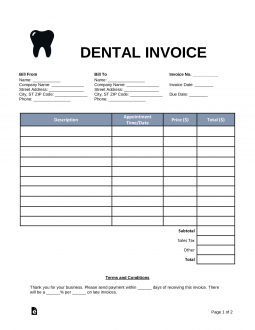Updated May 31, 2023
A dental invoice is a form that is used, generally by an office manager or office staff of a dental office, to bill a dental patient for dental services. The dental office may present the document for immediate payment after the visit or they may elect to first bill the insurance company and bill the patient for the remaining amount due (if any). The dentist should include all of the materials as well as the cost per service or hours of service provided, in the charges. Dental offices generally bill patients in specific billing cycles but may also require payment at the time of the visit.
Elements of a Dental Invoice
The dental invoice is a record of care and a formal request for payment. It should include descriptions of all services provided and their costs. In addition, the invoice should include:
- A date of issue
- Complete contact information for the patient
- Total payment that is due and the due date
- Penalties for late payment
This document should be prepared with care. The customer may use it to seek insurance reimbursement, or for tax purposes – plus, it reflects on the professionalism of the practice.
How to Bill a Dental Patient
1. Ask for insurance
All payment details should be arranged before treatment begins. In most offices and for most patients, insurance is the preferred route. But some policies require pre-authorization of procedures, so practices should be clear on particular insurance rules before providing services.
2. Make itemized costs of treatments
Treatments should be itemized and presented in appropriate detail in the Dental Invoice. Insurers often require specificity and may require other documentation to be affixed to the invoice too.
3. Present Dental Invoice to patient
The best case is to hand the invoice to the patient in-person. That way, there is no doubt that the patient has received it, and any confusion about costs and billing responsibilities can be ironed out on the spot. If mailing an invoice, a practice might consider following up with the patient to verify that it has been received, or else sending an email copy too.
4. Establish clear payment policies
Dental practices differ in their payment policies. While it is always wise to ensure that a consistent office billing protocol is in place, some dentists are more flexible in their terms. Practices may offer payment plans or operate on a billing cycle that means that all balances for a month or period are invoiced together and due at some common date in the future.
If an office will attempt to bill insurance on behalf of a patient, then the patient should be made aware that they bear ultimate responsibility for any uncovered balances. Some offices keep back-up credit card information on hand just in case insurance rejects a claim.



